
In Search of Meaning: Reflections on Folklore
Costis Drygianakis, Yiorgis Sakellariou
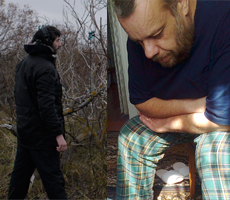
Left: Yiorgis. Right: Costis
The following is a conversation between electroacoustic music composers Costis Drygianakis and Yiorgis Sakellariou, both originating from Greece. Besides their compositional activities, Costis has been researching on and collecting folk music from Russia and other former Soviet republics while Yiorgis has done field work exploring music from Lithuania. His recordings are now part of the World and Traditional music archive of the British Library.
IN SEARCH OF MEANING: REFLECTIONS ON FOLKLORE
The conversation was triggered by a post on the British Library’s blog [1] in which Yiorgis describes his experiences of making recordings in Lithuania. Costis sent him an email with some thoughts which initiated the dialogue. They comment on the notion of tradition, the evolution of folk music and exchange thoughts on their experiences, comparing the current situation of Greek, Russian and Lithuanian music.
Costis Drygianakis:
[…] I would like to underline that the tradition, as we understand it today, was formulated to a great extent in the early 1900’s, mainly because of the development of the ethnographic research and the dissemination of the gramophone record. Up to then, it seems that unaccompanied singing was dominant in everyday life. In Russia, as well as in Greece. Instruments were used rather sparsely, in special cases like weddings or religious feasts. What is probably certain is that, as a part of everyday life activities, singing had none of the characteristics that were imposed on it by scholars and record-producers. For example there was no defined beginning, middle and ending in the songs, as there was no need for it. The lullaby was over when the baby was asleep, the working song when the work was finished. That is why there are similar melodies in different songs, or stand-alone lyrics etc. The concept of a musical “piece” (defined, complete and unique) was grown in Western art music and gradually enforced into folk music. The gramophone record, with its limited available time and its function within a commercial framework that caused the commodification of music, was a primary catalyst in this procedure. If older folk music was a continuum of melodies and lyrics, without defined borders (and defined owners too), then, after the spreading of the gramophone record it became a compendium of separate pieces. It is exactly this procedure that gave birth to the new concepts regarding “tradition”, these ones which became widespread in the post-war world. In Soviet Russia commerce was not as powerful as in the West, but the academic approach of the folklorists already had a decisive role, even from the last years before the 1917 Revolution. In many cases, the actual village music was transformed to a kind of spectacle, starting with researchers like Mitrofan Pyatnitsky. Today it is even more obvious if we consider that this repertoire is performed in “traditional”, old style folk costumes that are not used anywhere else anymore; it makes clear that the concert of this kind of music is something like a museum exhibition.
Yiorgis Sakellariou:
I have been rather troubled regarding the costumes. In a conversation I had with Austė Nakienė [2] she told me that naturally concerts and presentations at festivals have an artistic approach and mentality. She also added that we are essentially looking at a “postcard”, as she said characteristically, an idealized version (for whom, I wonder?). The ensembles are fully aware of that. It is not a matter of authenticity but presenting the work as beautiful and attractive as possible. Besides, the clothes were not so fancy 100 years ago, for example. They were much more simple and practical for work or other activities. Always according to Austė, exceptions were the Sunday mass, weddings and funerals.
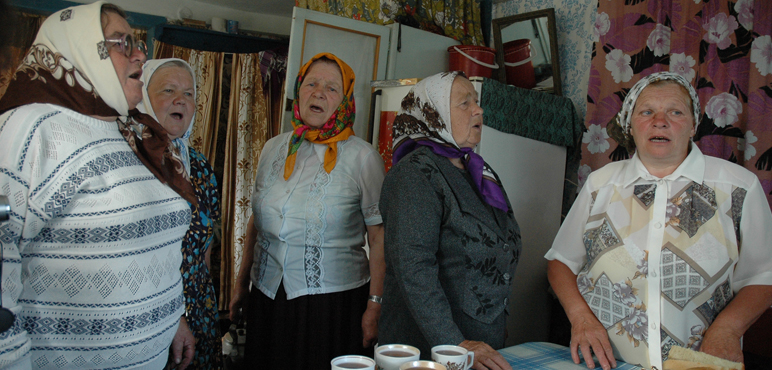 Russia: Sudarushki (“the Ladies”), the folk group of the village of Ilovka, rehearse at home. July 2005.
Russia: Sudarushki (“the Ladies”), the folk group of the village of Ilovka, rehearse at home. July 2005.
CD:
They say the same, more or less, in Russia. We are talking about a theatre-type approach that aims to present an idealized past. It is clear that this approach takes place in an urban, modern environment. Here, many of the teachers of the Academy [3] are aware of the changes of the framework but they are unwilling to take a different initiative. This theatrical approach is one of the typical Soviet remains that are still beyond question. I was really shocked in 2010 when I attended some exams of the students in the Academy where all of them performed in “traditional” costumes, although there was no audience besides their fellow students and their teachers.
This framework expands furthermore to the discography. The recording prerequisites in the studio are very specific, as I understood, but there you can see a gradual change of approach.
YS:
My question then would be “Why do we care?” If Russians, Lithuanians, etc. make this aesthetic choice why are we troubled so much? Especially since we do not have the ambition to defend tradition or good taste. Apparently over there they have resolved these issues so let’s just sit back and enjoy it.
CD:
I ’m not against any pleasure or enjoyment but I have two objections. Firstly, I disagree with this forging, or rather misinterpretation of history. Or, to put it milder, I disagree with the creation of public history intended for mass consumption; I find no fun in it. Besides the ideological disagreement, I feel that a lot of problems that we are dealing with in this specific field are caused exactly because of this attempt to invent or to shape traditions.
Secondly, regarding the Academia here in Russia, which I am a bit more familiar with, I don’t think they are enjoying themselves that much, neither themselves nor the people who listen to them. It is a form of compulsion. Of course when the aspect of pleasure is absent, music becomes pointless. Therefore, it is not strange that this repertoire does not have real listeners but only temporal ones (in national commemoration days etc), who attend it being obliged by the circumstances. That is why I am interested in how this music sounded when people still enjoyed it. Or, if we consider that it has not changed (though I am certain that it has), then what is it that has changed so that people do not enjoy it anymore although they used to (and who are these people, and so on). I do not know if in Lithuania the situation is different.
I would also add that this conservatism, as a motivating stimulus, is dangerous. It is not important to restore things as they used to be, but to understand what was then beautiful. If the old beautiful does not correspond with the contemporary one, we have to find out why.
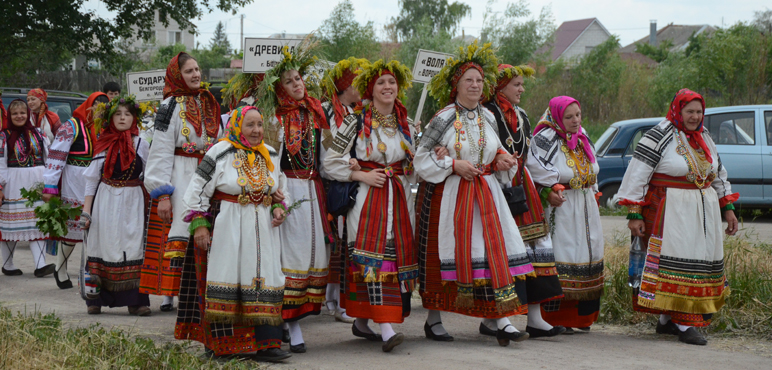 Russia: Volya, Sudarushki and other groups entering the ground of the annual festival of the Holy Trinity in Novaya Usman. June 2011.
Russia: Volya, Sudarushki and other groups entering the ground of the annual festival of the Holy Trinity in Novaya Usman. June 2011.
YS:
The original truth and purpose of these songs is gone, along with the conditions that gave birth to them. The practical purposes do not exist anymore (work in fields, lullaby etc.) and by default we listen to them out of context. Regardless of the differences in interpretation or orchestration, the changes are much deeper and are dealing with the meaning of both the song and its need to be sung.
I interviewed two young people who are members of the neo-folk/pagan ensemble Kūlgrinda. Out of curiosity I simply asked them why are they doing this; what motivates two youngsters to wear clothes that belong to another era and sing what they consider to be ancient pagan songs? The response from both was that it happened naturally and unforcedly. An initial curiosity was soon transformed into a passion.
However, as I wrote at the British Library blog, despite all the filters this music still has an impact because its original meaning, its reason to exist, was powerful and authentic. Perhaps a lot of people cannot relate or communicate with it but for sure they can understand, or feel, there is a strong meaning behind.
And I should emphasize again how many filters intercede. Changes in social conditions, new ideas and experiences from contemporary practitioners, our cultural distance, the recordings as such. I do not know if, after all, it is I who idealize my experiences. In any case, I share your questioning.
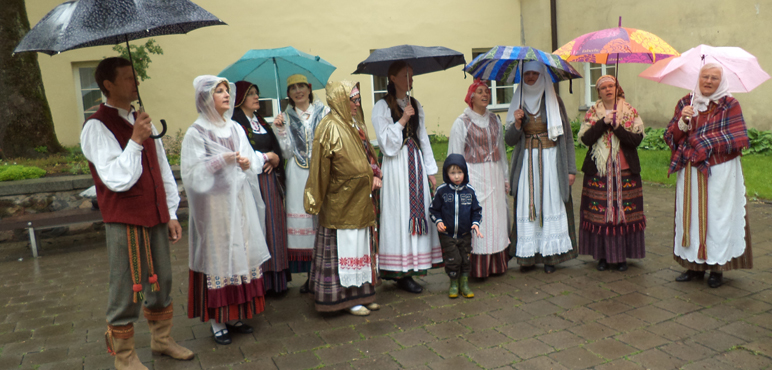 Lithuania: Gadula folk ensemble performing during the event Prašom, svečiai, kieminėt (Please, be my guest) at Vilnius old town. Skamba Skamba Kankliai festival. June 1, 2014.
Lithuania: Gadula folk ensemble performing during the event Prašom, svečiai, kieminėt (Please, be my guest) at Vilnius old town. Skamba Skamba Kankliai festival. June 1, 2014.
CD:
You put it correctly. The changes are massive and the new meanings and truths are totally different from the original ones. Even in the course of some years, meanings change.
Neo-pagan ensembles are, I think, another case. There is passion and devotion and somehow it is clear (though I doubt if it always is) that they do not correspond to any historic truth. It is an imagined community, as Anderson puts it [4].
YS:
In many ensembles which participated at Skamba Skamba Kankliai the members are people of old age, especially when the ensembles are not from Vilnius. There was a characteristic concert where Ringailiai, an ensemble from a village near Kaunas performed. In Ringailiai only old people participated and they were joined by members of Tatato, the ensemble of the Ethnomusicology Department of Lithuanian Academy of Music and Theatre, in which almost every member was a female student. I asked if the old people’s motivation is to preserve their traditions. The answer surprised me a bit. Apparently, many things happen for practical and not aesthetic or ideological reasons. Well, these grandmothers and grandfathers participate in the ensembles basically to have a good time. They meet, they socialize, they sing and occasionally they travel to perform in festivals. There are no ideological purposes of preserving tradition or originality.
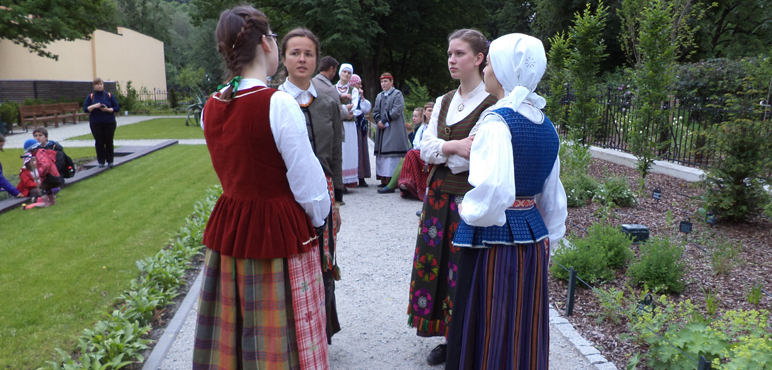 Lithuania: Tatato, the ensemble of the Ethnomusicology Department of Lithuanian Academy of Music of Theatre performing during the event Sutartinių takas (Alley of sutartines) at Bernardinų sode, Vilnius. Skamba Skamba Kankliai festival. May 30, 2014.
Lithuania: Tatato, the ensemble of the Ethnomusicology Department of Lithuanian Academy of Music of Theatre performing during the event Sutartinių takas (Alley of sutartines) at Bernardinų sode, Vilnius. Skamba Skamba Kankliai festival. May 30, 2014.
CD:
Exactly. They don’t give a damn about tradition. Already the previous generation was educated, went to school, and used to listen to records of the then popular music. Tradition, as opposed to modernity (and therefore set under protection), is an idea that sprung out of the modern urban world. In the villages they have a somehow bitter feeling for the “tradition”, as the difficulties of the old way of life are not yet completely gone.
YS:
When I asked a couple of students if they are interested in an interview I got shyness in response and the occasional distant attitude of Lithuanians. So, I can only guess their motivations. I suppose they do it mechanically, as part of their studies perhaps. Maybe the younger generation feels an obligation to preserve something from the past.
CD:
Yes, I noticed the same thing here, despite the enthusiastic and warm attitude of Russians. I do not think they are very conscious of what they are doing and I am not at all certain that it is their choice to mingle with the “tradition”. Besides, they witness this haggard revival first hand. I don’t know how it is in Lithuania but in Russia it can be even cruel, sometimes.
By the way, Russians make fun of themselves on such topics. There was a very successful song about it in Russia, right after the collapse of the Soviet Union, called American boy; describing the struggle of a Russian teen who plays the balalaika and dreams to go to Jamaica, but there are no babalaikas there, so her knowledge is useless in her struggle to migrate. [5]
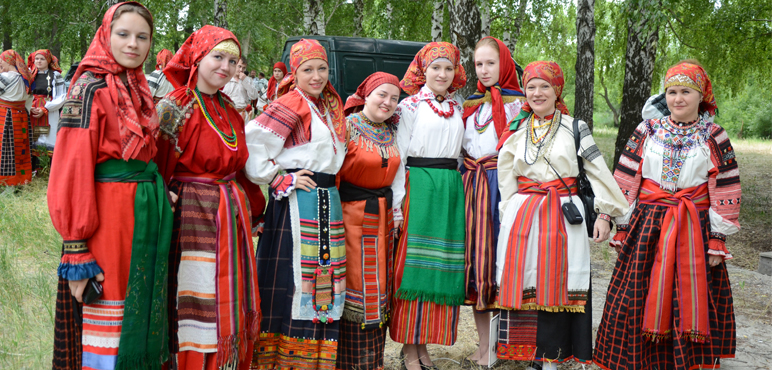 Russia: Terem (“the Room under the roof”), a group of amateurs, all graduates of the Voronezh State University, under the direction of Galina Khristova (second from right), a little after performing at the annual festival of the Holy Trinity in Novaya Usman. June 2011.
Russia: Terem (“the Room under the roof”), a group of amateurs, all graduates of the Voronezh State University, under the direction of Galina Khristova (second from right), a little after performing at the annual festival of the Holy Trinity in Novaya Usman. June 2011.
YS:
Nonetheless, Austė was rather positive for ensembles that add new elements. She called them post-modern. I have listened some, for example Atalyja [6], who combine rock orchestrations with traditional melodies and moreover it is very important that they add new lyrics on old melodies.
CD:
I agree with her. This is not sterile attachment to the supposed tradition but a new contextualization and thus, I think, a generally healthy procedure. There have been such approaches here too (I think the group Ivan Kupala [7] is one of the most striking examples) but they met the harsh critics of the academic system.
Here I would note that both you and I approached the so-called traditional music with our love for the Other as a basic motivation. I think it is a crucial point which radically differentiates our approach from the approach of the academies. Consider our homeland, Greece; the old traditions were not part of our everyday life when we grew up. The same goes for our life in the countries we later migrated to. In Greece there were records with traditional music, we had some in our house, but this wasn’t in a village. It was in an urban environment, where the “natural” everyday music would be pop or rock and so on. Our searches (in both the so-called contemporary and traditional music) are triggered by our interest of what lies beyond our mundane life, this Other. For the people who live in a village, the relation to what we call tradition is totally different (ranging probably from an unbearable burden to a source of income through tourism).
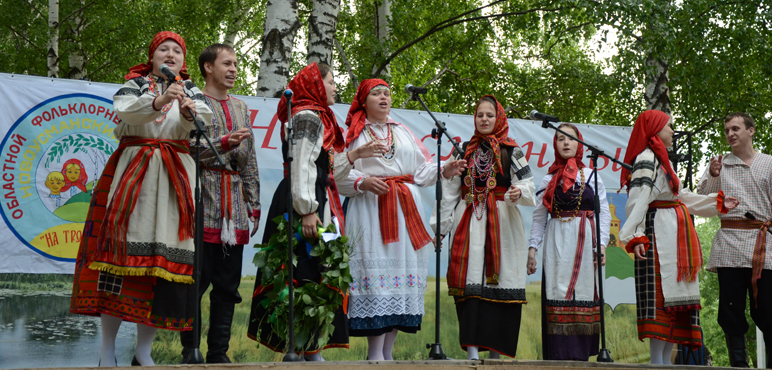 Russia: Volya (“Will, Freedom”), the student group of the Department for Folk Music of the Voronezh State University, under the direction of Galyna Sysoeva (not depicted here) performs at the annual festival of the Holy Trinity in Novaya Usman. June 2011.
Russia: Volya (“Will, Freedom”), the student group of the Department for Folk Music of the Voronezh State University, under the direction of Galyna Sysoeva (not depicted here) performs at the annual festival of the Holy Trinity in Novaya Usman. June 2011.
YS:
I have additionally the experience of studying traditional Mediterranean music at the conservatory. Of course I had a curiosity for the Other, the more unworldly. That is how the Arabic, or Byzantine if you prefer, scales, the unusual time signatures and the drones were sounding to my ears back then.
My teacher, Nikos Grapsas, lend me a CD with music from Istanbul. On the cover there was a photo of the musicians, one of them was holding a cello. I was surprised as the cello is a Western instrument and I asked him how it got there. “They played anything they could get their hands on”, he replied. “Probably a relative went on a journey and came back with a new instrument. They had absolutely no reason not to use it at once.”
And there is another, perhaps irrelevant story that Austė told me and which I find interesting. The accordion is rather connected to Lithuanian music tradition, especially polka dances. However, around 100 years ago the elders were extremely suspicious of it, in contrary with young musicians. For the elders the “proper” instrument was the bagpipe and the accordion was a stupid box that you just press buttons and music comes out. (Reminds me of the criticism against computer music). The young musicians however liked the loud and clear sound and the fact that the accordion would not get out of tune.
CD:
Your story is not irrelevant, it showcases the dynamic of things. In older days music of this type was open to new elements, basically by obeying practical needs. The obsession with the old (“because this is how things were”) is modern, it is the extreme notion with which the supposed “traditional” musicians clash. Of course this changes from place to place, era to era etc. In previous times, and in most places, the musician (the singer, the lyricist, the painter, every creative person) was part of the intellectual elite, now the “traditional musician” is a kind of remains.
Such questioning has not a lot of appeal in Russia. On the contrary, the idea of reflexivity which became crucial in Western anthropology the last decades, it is rarely touched: “This is how we found it, this is the way we will keep on doing it, until the end of time”. It doesn’t matter so much if they found it already constructed by some previous folklorists. Modern elements that are spring up in the process of research (e.g. structuring songs for recording or concert purpose) are hushed up, consciously or unconsciously, gradually creating a thick layer of “common sense” from which the community of the researchers cannot easily escape from. Questions regarding the methods of ethnography, the identity of the researcher etc, here in Russia are extremely limited and are dealing only with obvious issues, as for example with the injection of pro-state lyrics in the Soviet years. Maybe this is because ethnography in Russia developed as a part of national study and not as a study of foreign cultures, as was the case in the West.
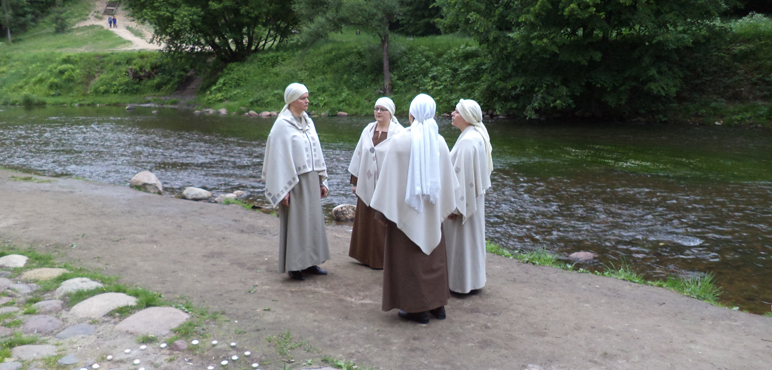 Lithuania: Trys Keturiose performing, under the direction of Daiva Vyčinienė (first on the left), during the event Sutartinių takas (Alley of sutartines) at Bernardinų sode, Vilnius. Skamba Skamba Kankliai festival. May 30, 2014.
Lithuania: Trys Keturiose performing, under the direction of Daiva Vyčinienė (first on the left), during the event Sutartinių takas (Alley of sutartines) at Bernardinų sode, Vilnius. Skamba Skamba Kankliai festival. May 30, 2014.
YS:
I’d like to express my concern as an ethnographer. By adding my recordings to the British Library archives I have contributed, even a little bit, to the documentation and archiving of Lithuanian music.
What worries me is how inevitably limited my collection is. At least I am consciously aware of that. While I was living in Lithuania I never collected material methodically but more instinctively and based on my taste. No doubt this influenced my recordings and the decisions I made during the Skamba Skamba Kankliai festival. I already knew some participating ensembles, some I did not, some styles I liked (sutartines), some not (polkas). There is also the fact that I collaborated with only one ethnomusicologist. She obviously has very broad knowledge of the subject but she remains only one source of information and undoubtedly she has her own personal taste and opinion. And, of course, Skamba Skamba Kankliai’s program, no matter how diverse, was still fragmented.
Therefore, the fact that this collection is part of the archives of the British Library makes it perhaps overvalued. Maybe I am exaggerating now but I think there is an issue of “authority” as the prestige and status of institutes with reputation, power and resources affect the work to a great degree.
CD:
You are right. I have also thought about this from time to time, although I’ve never had a powerful institute to back me up. Moreover, I completely agree with the observation that the world of music (of Lithuania, of Greece, of Russia or anywhere else) includes the work of everyone involved (village singers, ethnographers, entertainers, pop stars etc.) but no one is above it. No one has the complete knowledge in his head.
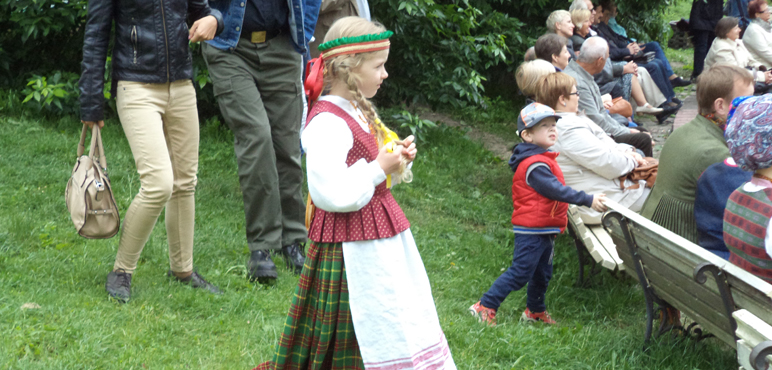 Lithuania: A young participant at Skamba Skamba Kankliai, waiting for her turn to go on stage at Teatro, muzikos ir kino muziejaus kieme (the courtyard of the Lithuanian Theater, Music and Cinema Museum), Vilnius. May 29, 2014.
Lithuania: A young participant at Skamba Skamba Kankliai, waiting for her turn to go on stage at Teatro, muzikos ir kino muziejaus kieme (the courtyard of the Lithuanian Theater, Music and Cinema Museum), Vilnius. May 29, 2014.
Notes
1. In the post Sakellariou talks about Skamba Skamba Kankliai, a festival of traditional music that takes place in Lithuania.
http://britishlibrary.typepad.co.uk/sound-and-vision/2014/07/recordings-from-the-skamba-skamba-kankliai-music-festival-lithuania.html
2. Austė Nakienė is an ethnomusicologist working in the Lithuanian Institute of Folklore and Literature (http://www.llti.lt/en/about/). She provided valuable assistance to Yiorgis Sakellariou during the Skamba Skamba Kankliai 2014 recording project.
3. The Academy is the State Academy of the Arts in Voronezh, where there is a faculty of Folk Music, directed by Galina Sysoeva.
4. Anderson Benedict, 2006: Imagined communities: Reflections on the Origin and Spread of Nationalism, Revised Edition. London: Verso
5. American boy by the group Kombinatsiya:
https://www.youtube.com/watch?v=W7hAo28NCXc
6. Atalyja can be heard here:
https://www.youtube.com/watch?v=lbJ4HX90S6U
7. Ivan Kupala can be heard here:
http://www.youtube.com/watch?v=zhNSpilaw0E
Links
● British Library sound archive
http://sounds.bl.uk/
● Skamba Skamba Kankliai festival
http://www.etno.lt/index.php/lt/skamba-skamba-kankliai
● Volya, the folk group of the Voronezh State Arts Academy
http://www.youtube.com/watch?v=Wu9rtV2YomQ
● Costis Drygianakis
http://soundcloud.com/costisdrygianakis
● Yiorgis Sakellariou
http://mechaorga.wordpress.com/
- Travelling alone, but not quite
- Moving with the Song: Loss and Longing in the Migrations of Bengal
- Songs from a Tide-Swept Land
- Sonic Symphony
- Art East: Eastern India’s stories of Partition
- শ্রবণ
- মনসামঙ্গল ও একটি এটলাস ছাতার গল্প
- Man with a Recording Machine: Arnold Bake in Bengal
- Images of Listening
- Madly in Love: On a Trail of Songs of Separation
- শাহ আবদুল করিমের ভাব ও অভাবের গান
- I Hear the Drums Roll: Lessons in the Art of Listening
- Stories as Songs: Oral Traditions in the Khasi Hills
- BF Shelton and Oh Molly Dear
- ‘Accuse’ কাকে করবো?
- দ্য ট্র্যাভেলিং আর্কাইভ: শ্রবণ, স্মৃতি আর সময়ের গল্প
